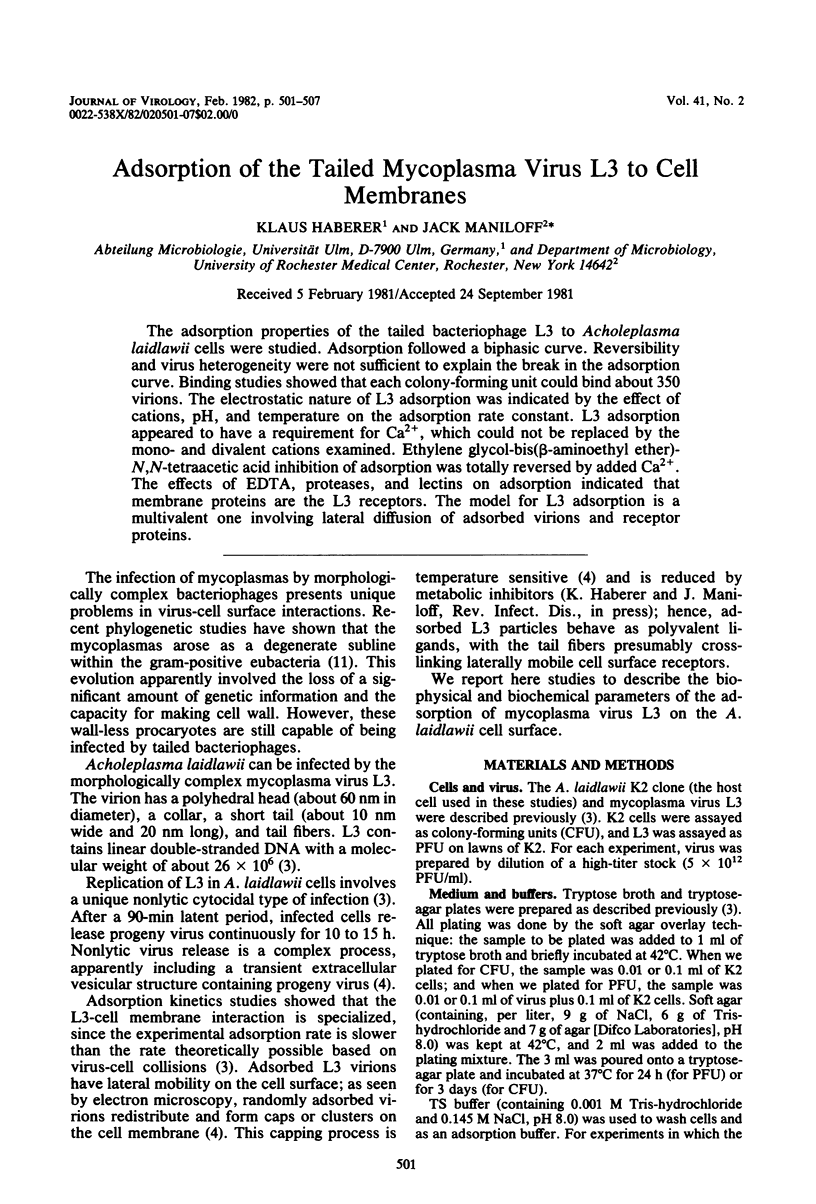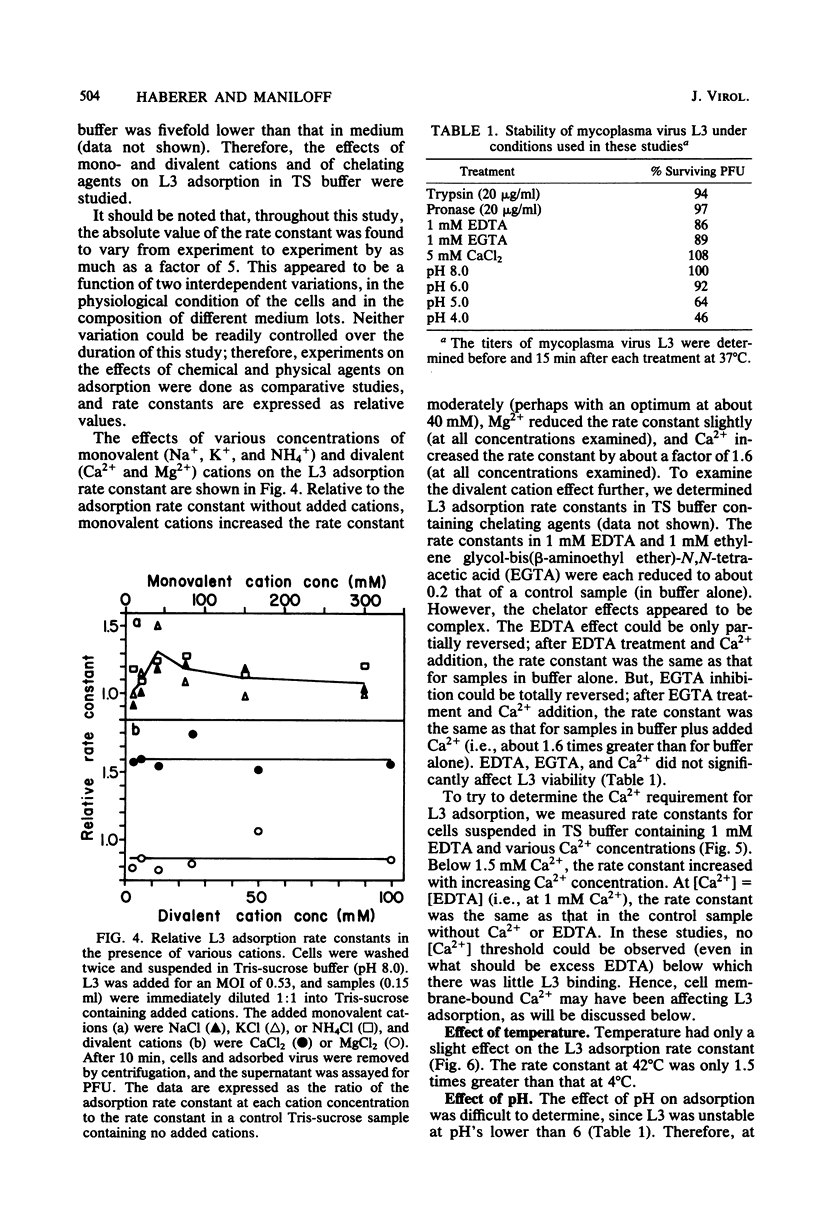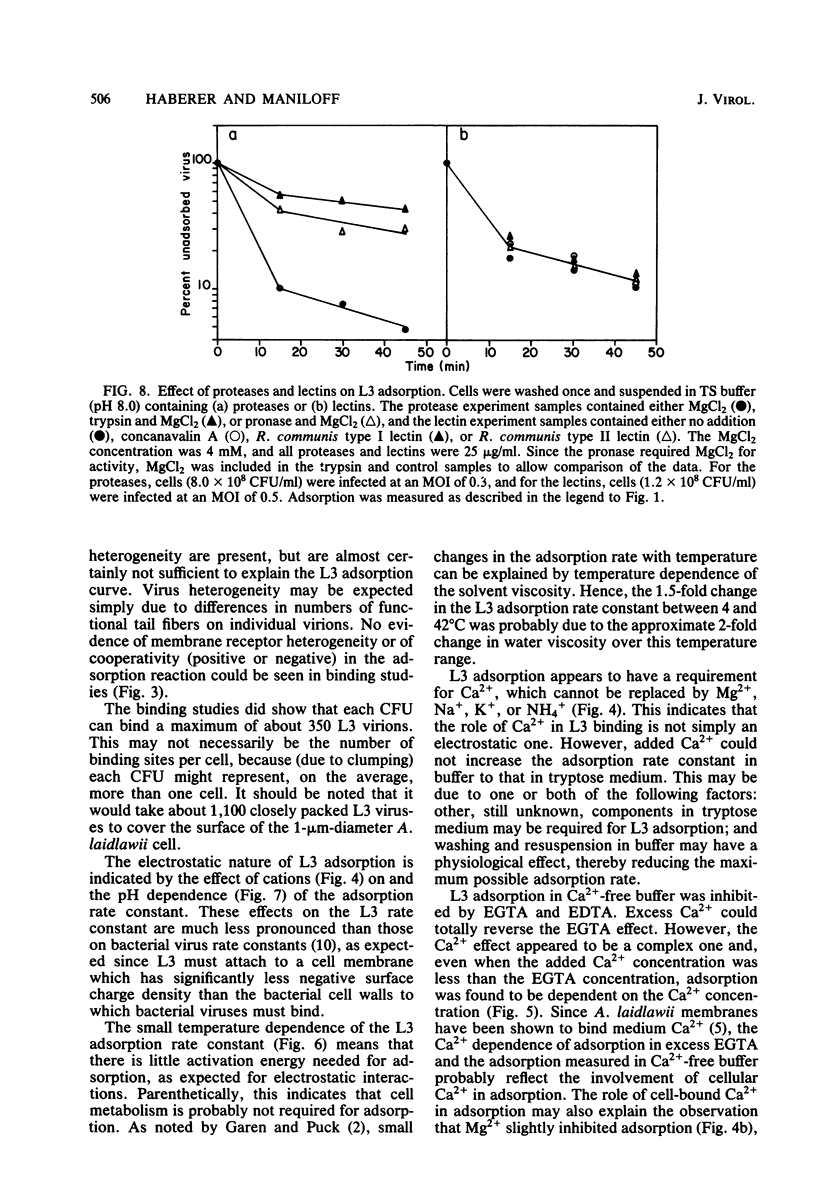Abstract
The adsorption properties of the tailed bacteriophage L3 to Acholeplasma laidlawii cells were studied. Adsorption followed a biphasic curve. Reversibility and virus heterogeneity were not sufficient to explain the break in the adsorption curve. Binding studies showed that each colony-forming unit could bind about 350 virions. The electrostatic nature of L3 adsorption was indicated by the effect of cations, pH, and temperature on the adsorption rate constant. L3 adsorption appeared to have a requirement for Ca2+, which could not be replaced by the mono- and divalent cations examined. Ethylene glycol-bis(beta-aminoethyl ether)-N,N-tetraacetic acid inhibition of adsorption was totally reversed by added Ca2+. The effects of EDTA, proteases, and lectins on absorption indicated that membrane proteins are the L3 receptors. The model for L3 adsorption is a multivalent one involving lateral diffusion of adsorbed virions and receptor proteins.
Full text
PDF






Selected References
These references are in PubMed. This may not be the complete list of references from this article.
- Christensen J. R. The kinetics of reversible and irreversible attachment of bacteriophage T-1. Virology. 1965 Aug;26(4):727–737. doi: 10.1016/0042-6822(65)90336-3. [DOI] [PubMed] [Google Scholar]
- GAREN A., PUCK T. T. The first two steps of the invasion of host cells by bacterial viruses. II. J Exp Med. 1951 Sep;94(3):177–189. doi: 10.1084/jem.94.3.177. [DOI] [PMC free article] [PubMed] [Google Scholar]
- Haberer K., Klotz G., Maniloff J., Kleinschmidt A. K. Structural and biological properties of mycoplasmavirus MVL3: an unusual virus-procaryote interaction. J Virol. 1979 Oct;32(1):268–275. doi: 10.1128/jvi.32.1.268-275.1979. [DOI] [PMC free article] [PubMed] [Google Scholar]
- Haberer K., Maniloff J., Gerling D. Adsorption, capping, and release of a complex bacteriophage by mycoplasma cells. J Virol. 1980 Oct;36(1):264–270. doi: 10.1128/jvi.36.1.264-270.1980. [DOI] [PMC free article] [PubMed] [Google Scholar]
- Kahane I., Ne'eman Z., Razin S. Divalent cations in native and reaggregated mycoplasma membranes. J Bacteriol. 1973 Feb;113(2):666–671. doi: 10.1128/jb.113.2.666-671.1973. [DOI] [PMC free article] [PubMed] [Google Scholar]
- Kahane I., Tully J. G. Binding of plant lectins to mycoplasma cells and membranes. J Bacteriol. 1976 Oct;128(1):1–7. doi: 10.1128/jb.128.1.1-7.1976. [DOI] [PMC free article] [PubMed] [Google Scholar]
- Ne'eman Z., Kahane I., Razin S. Characterization of the mycoplasma membrane proteins. II. Solubilization and enzymic activities of Acholeplasma laidlawii membrane proteins. Biochim Biophys Acta. 1971 Oct 12;249(1):169–176. doi: 10.1016/0005-2736(71)90093-9. [DOI] [PubMed] [Google Scholar]
- Schiefer H. G., Gerhardt U., Brunner H., Krüpe M. Studies with lectins on the surface carbohydrate structures of mycoplasma membranes. J Bacteriol. 1974 Oct;120(1):81–88. doi: 10.1128/jb.120.1.81-88.1974. [DOI] [PMC free article] [PubMed] [Google Scholar]
- TOLMACH L. J. Attachment and penetration of cells by viruses. Adv Virus Res. 1957;4:63–110. doi: 10.1016/s0065-3527(08)60596-5. [DOI] [PubMed] [Google Scholar]
- Woese C. R., Maniloff J., Zablen L. B. Phylogenetic analysis of the mycoplasmas. Proc Natl Acad Sci U S A. 1980 Jan;77(1):494–498. doi: 10.1073/pnas.77.1.494. [DOI] [PMC free article] [PubMed] [Google Scholar]


